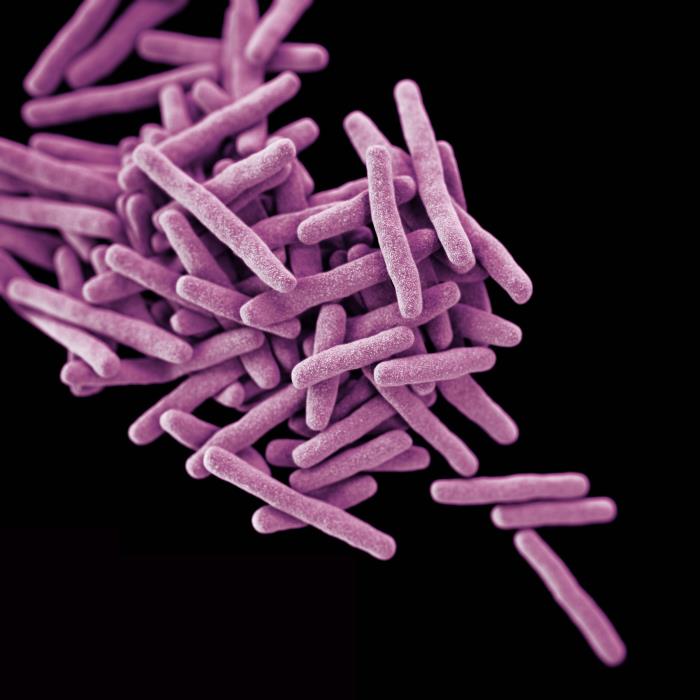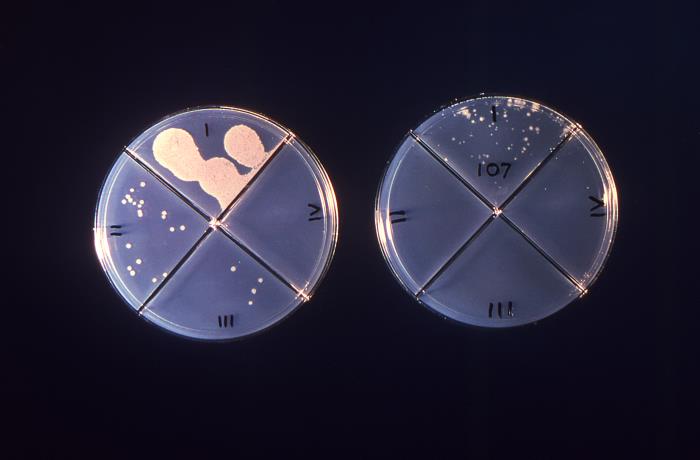Mycobacterium tuberculosis: Difference between revisions
m (Changes made per Mahshid's request) |
Mohamed riad (talk | contribs) |
||
| (2 intermediate revisions by 2 users not shown) | |||
| Line 1: | Line 1: | ||
__NOTOC__ | __NOTOC__ | ||
{{Tuberculosis}} | {{Tuberculosis}} | ||
{{CMG}}; {{AE}} {{JS}} | {{CMG}}; {{AE}} {{Mashal Awais}}; {{JS}} | ||
{{About0|Tuberculosis}} | {{About0|Tuberculosis}} | ||
{{SK}} M. Tuberculosis | {{SK}} M. Tuberculosis | ||
==Overview== | ==Overview== | ||
Mycobacterium tuberculosis is the [[bacterium]] responsible for [[tuberculosis]]. | [[Mycobacterium tuberculosis]] is the [[bacterium]] responsible for [[tuberculosis]]. M. tuberculosis is an [[obligate aerobe]], [[capsule|non-encapsulated]], [[motility|non-motile]], [[acid-fast]] [[bacillus]]. . M. tuberculosis is one of the '''Mycobacterium tuberculosis''' complex, which also includes [[bacteria]], such as [[Mycobacterium bovis|M. bovis]] and M. africanum. The bacterium has a very slow rate of [[replication]], and its [[genetic]] variations account for the different [[strains]] and the growing [[drug resistance]]. M. tuberculosis has [[tropism]] for different kinds of human cells, with preference for cells of the [[lung]]. The main [[natural reservoir]] for ''M. [[tuberculosis]] are'' [[Human]] beings'';'' however, the [[bacteria]] can also [[Infection|infect]] other [[species]]. | ||
==Taxonomy== | ==Taxonomy== | ||
{| style="float: right;" | {| style="float: right;" | ||
| [[File:M.tuberculosis1.jpg|200px|thumb|none|Computer-generated image of a cluster of rod-shaped drug-resistant Mycobacterium tuberculosis bacteria.<SMALL> ''Image provided by the CDC [http://phil.cdc.gov/phil/details.asp Centers for Disease Control and Prevention] ''<ref>{{Cite web | title = http://phil.cdc.gov/phil/details.asp | url = http://phil.cdc.gov/phil/details.asp}}</ref></SMALL>]] | |[[File:M.tuberculosis1.jpg|200px|thumb|none|Computer-generated image of a cluster of rod-shaped drug-resistant Mycobacterium tuberculosis bacteria.<SMALL> ''Image provided by the CDC [http://phil.cdc.gov/phil/details.asp Centers for Disease Control and Prevention] ''<ref>{{Cite web | title = http://phil.cdc.gov/phil/details.asp | url = http://phil.cdc.gov/phil/details.asp}}</ref></SMALL>]] | ||
|- | |- | ||
| [[File:M. tuberculosis2.jpg|200px|thumb|none|Thin agar culture plates reveal the results of a drug susceptibility test on Mycobacterium tuberculosis bacteria <SMALL> ''Image provided by the CDC [http://phil.cdc.gov/phil/details.asp Centers for Disease Control and Prevention] ''<ref>{{Cite web | title = http://phil.cdc.gov/phil/details.asp | url = http://phil.cdc.gov/phil/details.asp}}</ref></SMALL>]] | |[[File:M. tuberculosis2.jpg|200px|thumb|none|Thin agar culture plates reveal the results of a drug susceptibility test on Mycobacterium tuberculosis bacteria <SMALL> ''Image provided by the CDC [http://phil.cdc.gov/phil/details.asp Centers for Disease Control and Prevention] ''<ref>{{Cite web | title = http://phil.cdc.gov/phil/details.asp | url = http://phil.cdc.gov/phil/details.asp}}</ref></SMALL>]] | ||
|} | |} | ||
Cellular organisms; [[bacteria]]; [[Actinobacteria]]; [[Actinobacteria]]; [[Actinobacteridae]]; [[Actinomycetales]]; [[Corynebacterineae]]; [[Mycobacteriaceae]]; ''[[Mycobacterium]]''; Mycobacterium tuberculosis complex; ''M. tuberculosis''<ref name=NCBI>{{cite web | title = Mycobacterium tuberculosis | url = http://www.ncbi.nlm.nih.gov/Taxonomy/Browser/wwwtax.cgi?id=1773 }}</ref> | Cellular organisms; [[bacteria]]; [[Actinobacteria]]; [[Actinobacteria]]; [[Actinobacteridae]]; [[Actinomycetales]]; [[Corynebacterineae]]; [[Mycobacteriaceae]]; ''[[Mycobacterium]]''; Mycobacterium tuberculosis complex; ''M. tuberculosis''<ref name="NCBI">{{cite web | title = Mycobacterium tuberculosis | url = http://www.ncbi.nlm.nih.gov/Taxonomy/Browser/wwwtax.cgi?id=1773 }}</ref> | ||
==Biology== | ==Biology== | ||
''M. tuberculosis'' | * ''[[Mycobacterium tuberculosis]]'' belongs to the Mycobacterium tuberculosis complex. This complex includes ''M. tuberculosis'', ''[[Mycobacterium bovis|M. bovis]]'', ''[[M. africanum]]'', ''M. canetti'', and [[M. microti.|''M. microti''.]]<ref name="pmid21420161">{{cite journal| author=Lawn SD, Zumla AI| title=Tuberculosis. | journal=Lancet | year= 2011 | volume= 378 | issue= 9785 | pages= 57-72 | pmid=21420161 | doi=10.1016/S0140-6736(10)62173-3 | pmc= | url=http://www.ncbi.nlm.nih.gov/entrez/eutils/elink.fcgi?dbfrom=pubmed&tool=sumsearch.org/cite&retmode=ref&cmd=prlinks&id=21420161 }} </ref> | ||
Genetic | * ''M. tuberculosis'' is an [[obligate aerobe]], [[capsule|non-encapsulated]], [[motility|non-motile]], [[acid-fast]] [[bacillus]]. | ||
* Its shape is [[slender]], straight or slightly [[curved]] [[bacillus]] with rounded ends. | |||
* It can be present [[singly]], in pairs or in small groups or [[clumps]]. | |||
* It cannot form [[spores]]. | |||
* It favors [[Tissue (biology)|tissues]] with high [[oxygen]] levels. | |||
* Due to the high [[lipid]] and [[mycolic acid]] content of its [[cell wall]], It stains weakly [[gram-positive]] or does not retain the [[dye]]. | |||
* [[Microscopic examination]] of [[sputum]] [[samples]] cannot differentiate it from other [[acid-fast]] bacteria, such as [[Nocardia]] spp.<ref name="pmid21420161">{{cite journal| author=Lawn SD, Zumla AI| title=Tuberculosis. | journal=Lancet | year= 2011 | volume= 378 | issue= 9785 | pages= 57-72 | pmid=21420161 | doi=10.1016/S0140-6736(10)62173-3 | pmc= | url=http://www.ncbi.nlm.nih.gov/entrez/eutils/elink.fcgi?dbfrom=pubmed&tool=sumsearch.org/cite&retmode=ref&cmd=prlinks&id=21420161 }} </ref> | |||
* ''M. [[tuberculosis]]'' [[divides]] every 15-20 hours which is considered an extremely low rate of [[Division (biology)|division]]. This feature, in addition to its ability to remain latent for long time, are responsible for the long [[treatment]] duration needed.<ref name="pmid21420161">{{cite journal| author=Lawn SD, Zumla AI| title=Tuberculosis. | journal=Lancet | year= 2011 | volume= 378 | issue= 9785 | pages= 57-72 | pmid=21420161 | doi=10.1016/S0140-6736(10)62173-3 | pmc= | url=http://www.ncbi.nlm.nih.gov/entrez/eutils/elink.fcgi?dbfrom=pubmed&tool=sumsearch.org/cite&retmode=ref&cmd=prlinks&id=21420161 }} </ref> | |||
* It can withstand dryness for weeks and also weak [[Disinfectant|disinfectants]]. | |||
* Genetic variations in the ''M. tuberculosis'' [[genome]] lead to important [[phenotypical]] changes. As a result, there are several variable [[strains]] of the [[bacteria]], six of which have particular [[Geographical isolation|geographical]] distribution. Three [[strains]], the ''[[Beijing family]]'', ''strain W'' and the ''W-like strains'', were reported to be associated with higher [[Incidence (epidemiology)|incidence]] of [[multi-drug resistance]].<ref name="pmid19483712">{{cite journal| author=Smith NH, Hewinson RG, Kremer K, Brosch R, Gordon SV| title=Myths and misconceptions: the origin and evolution of Mycobacterium tuberculosis. | journal=Nat Rev Microbiol | year= 2009 | volume= 7 | issue= 7 | pages= 537-44 | pmid=19483712 | doi=10.1038/nrmicro2165 | pmc= | url=http://www.ncbi.nlm.nih.gov/entrez/eutils/elink.fcgi?dbfrom=pubmed&tool=sumsearch.org/cite&retmode=ref&cmd=prlinks&id=19483712 }} </ref><ref name="pmid17448936">{{cite journal| author=Gagneux S, Small PM| title=Global phylogeography of Mycobacterium tuberculosis and implications for tuberculosis product development. | journal=Lancet Infect Dis | year= 2007 | volume= 7 | issue= 5 | pages= 328-37 | pmid=17448936 | doi=10.1016/S1473-3099(07)70108-1 | pmc= | url=http://www.ncbi.nlm.nih.gov/entrez/eutils/elink.fcgi?dbfrom=pubmed&tool=sumsearch.org/cite&retmode=ref&cmd=prlinks&id=17448936 }} </ref> | |||
==Tropism== | ==Tropism== | ||
There is no particular tissue [[tropism]] for M. [[tuberculosis]] and it can infect almost all human tissues. However, M. [[tuberculosis]] prefers tissues with high levels of [[oxygen]] , hence, [[pulmonary tuberculosis]] has the highest rate. <ref name="pmid21420161">{{cite journal| author=Lawn SD, Zumla AI| title=Tuberculosis. | journal=Lancet | year= 2011 | volume= 378 | issue= 9785 | pages= 57-72 | pmid=21420161 | doi=10.1016/S0140-6736(10)62173-3 | pmc= | url=http://www.ncbi.nlm.nih.gov/entrez/eutils/elink.fcgi?dbfrom=pubmed&tool=sumsearch.org/cite&retmode=ref&cmd=prlinks&id=21420161 }} </ref> | |||
==Natural Reservoir== | ==Natural Reservoir== | ||
The main [[natural reservoir]] for ''M. [[tuberculosis]] are [[Human]] beings;'' however, the [[bacteria]] can also [[Infection|infect]] other [[species]].<ref name="pmid21420161">{{cite journal| author=Lawn SD, Zumla AI| title=Tuberculosis. | journal=Lancet | year= 2011 | volume= 378 | issue= 9785 | pages= 57-72 | pmid=21420161 | doi=10.1016/S0140-6736(10)62173-3 | pmc= | url=http://www.ncbi.nlm.nih.gov/entrez/eutils/elink.fcgi?dbfrom=pubmed&tool=sumsearch.org/cite&retmode=ref&cmd=prlinks&id=21420161 }} </ref> | |||
==References== | ==References== | ||
Latest revision as of 06:17, 1 March 2021
|
Tuberculosis Microchapters |
|
Diagnosis |
|---|
|
Treatment |
|
Case Studies |
|
Mycobacterium tuberculosis On the Web |
|
American Roentgen Ray Society Images of Mycobacterium tuberculosis |
|
Risk calculators and risk factors for Mycobacterium tuberculosis |
Editor-In-Chief: C. Michael Gibson, M.S., M.D. [1]; Associate Editor(s)-in-Chief: Mashal Awais, M.D.[2]; João André Alves Silva, M.D. [3]
Synonyms and keywords: M. Tuberculosis
Overview
Mycobacterium tuberculosis is the bacterium responsible for tuberculosis. M. tuberculosis is an obligate aerobe, non-encapsulated, non-motile, acid-fast bacillus. . M. tuberculosis is one of the Mycobacterium tuberculosis complex, which also includes bacteria, such as M. bovis and M. africanum. The bacterium has a very slow rate of replication, and its genetic variations account for the different strains and the growing drug resistance. M. tuberculosis has tropism for different kinds of human cells, with preference for cells of the lung. The main natural reservoir for M. tuberculosis are Human beings; however, the bacteria can also infect other species.
Taxonomy
 |
 |
Cellular organisms; bacteria; Actinobacteria; Actinobacteria; Actinobacteridae; Actinomycetales; Corynebacterineae; Mycobacteriaceae; Mycobacterium; Mycobacterium tuberculosis complex; M. tuberculosis[3]
Biology
- Mycobacterium tuberculosis belongs to the Mycobacterium tuberculosis complex. This complex includes M. tuberculosis, M. bovis, M. africanum, M. canetti, and M. microti.[4]
- M. tuberculosis is an obligate aerobe, non-encapsulated, non-motile, acid-fast bacillus.
- Its shape is slender, straight or slightly curved bacillus with rounded ends.
- It can be present singly, in pairs or in small groups or clumps.
- It cannot form spores.
- It favors tissues with high oxygen levels.
- Due to the high lipid and mycolic acid content of its cell wall, It stains weakly gram-positive or does not retain the dye.
- Microscopic examination of sputum samples cannot differentiate it from other acid-fast bacteria, such as Nocardia spp.[4]
- M. tuberculosis divides every 15-20 hours which is considered an extremely low rate of division. This feature, in addition to its ability to remain latent for long time, are responsible for the long treatment duration needed.[4]
- It can withstand dryness for weeks and also weak disinfectants.
- Genetic variations in the M. tuberculosis genome lead to important phenotypical changes. As a result, there are several variable strains of the bacteria, six of which have particular geographical distribution. Three strains, the Beijing family, strain W and the W-like strains, were reported to be associated with higher incidence of multi-drug resistance.[5][6]
Tropism
There is no particular tissue tropism for M. tuberculosis and it can infect almost all human tissues. However, M. tuberculosis prefers tissues with high levels of oxygen , hence, pulmonary tuberculosis has the highest rate. [4]
Natural Reservoir
The main natural reservoir for M. tuberculosis are Human beings; however, the bacteria can also infect other species.[4]
References
- ↑ "http://phil.cdc.gov/phil/details.asp". External link in
|title=(help) - ↑ "http://phil.cdc.gov/phil/details.asp". External link in
|title=(help) - ↑ "Mycobacterium tuberculosis".
- ↑ 4.0 4.1 4.2 4.3 4.4 Lawn SD, Zumla AI (2011). "Tuberculosis". Lancet. 378 (9785): 57–72. doi:10.1016/S0140-6736(10)62173-3. PMID 21420161.
- ↑ Smith NH, Hewinson RG, Kremer K, Brosch R, Gordon SV (2009). "Myths and misconceptions: the origin and evolution of Mycobacterium tuberculosis". Nat Rev Microbiol. 7 (7): 537–44. doi:10.1038/nrmicro2165. PMID 19483712.
- ↑ Gagneux S, Small PM (2007). "Global phylogeography of Mycobacterium tuberculosis and implications for tuberculosis product development". Lancet Infect Dis. 7 (5): 328–37. doi:10.1016/S1473-3099(07)70108-1. PMID 17448936.